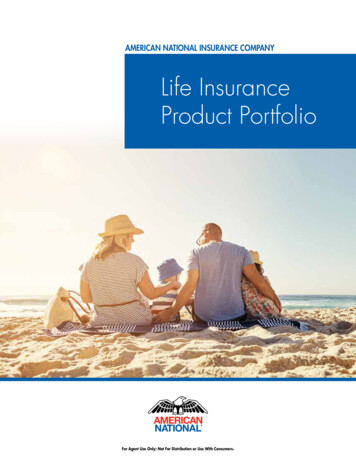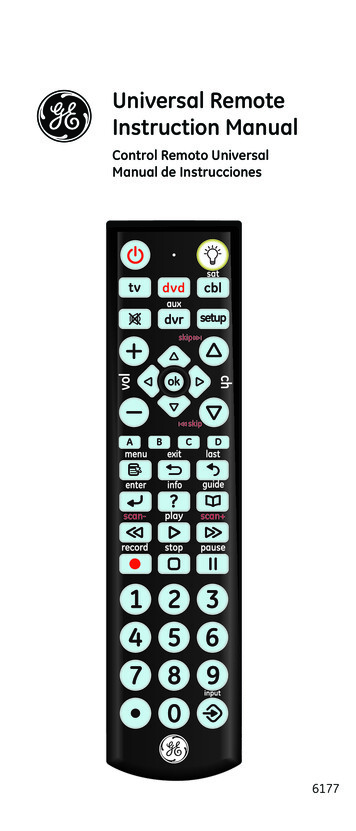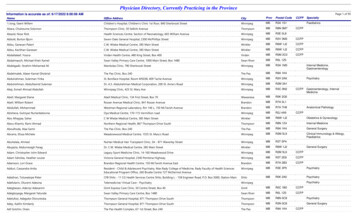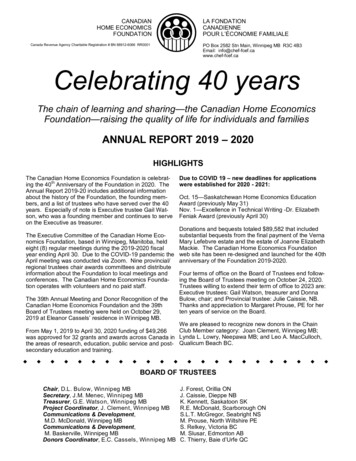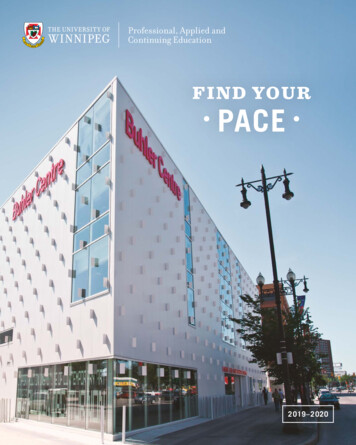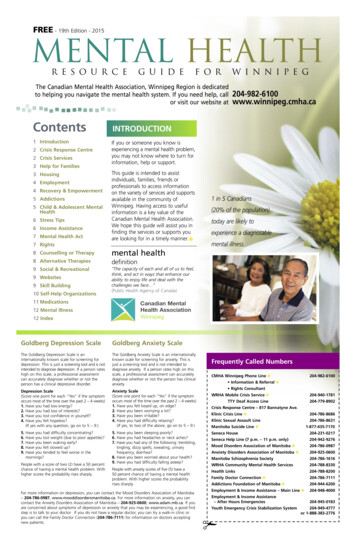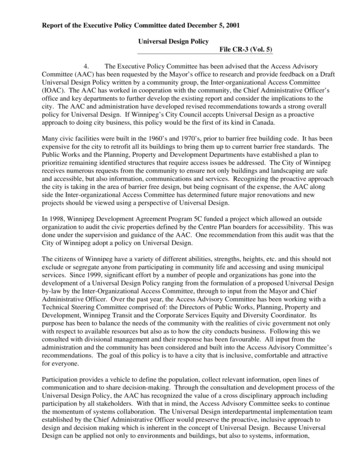
Transcription
Report of the Executive Policy Committee dated December 5, 2001Universal Design PolicyFile CR-3 (Vol. 5)4.The Executive Policy Committee has been advised that the Access AdvisoryCommittee (AAC) has been requested by the Mayor’s office to research and provide feedback on a DraftUniversal Design Policy written by a community group, the Inter-organizational Access Committee(IOAC). The AAC has worked in cooperation with the community, the Chief Administrative Officer’soffice and key departments to further develop the existing report and consider the implications to thecity. The AAC and administration have developed revised recommendations towards a strong overallpolicy for Universal Design. If Winnipeg’s City Council accepts Universal Design as a proactiveapproach to doing city business, this policy would be the first of its kind in Canada.Many civic facilities were built in the 1960’s and 1970’s, prior to barrier free building code. It has beenexpensive for the city to retrofit all its buildings to bring them up to current barrier free standards. ThePublic Works and the Planning, Property and Development Departments have established a plan toprioritize remaining identified structures that require access issues be addressed. The City of Winnipegreceives numerous requests from the community to ensure not only buildings and landscaping are safeand accessible, but also information, communications and services. Recognizing the proactive approachthe city is taking in the area of barrier free design, but being cognisant of the expense, the AAC alongside the Inter-organizational Access Committee has determined future major renovations and newprojects should be viewed using a perspective of Universal Design.In 1998, Winnipeg Development Agreement Program 5C funded a project which allowed an outsideorganization to audit the civic properties defined by the Centre Plan boarders for accessibility. This wasdone under the supervision and guidance of the AAC. One recommendation from this audit was that theCity of Winnipeg adopt a policy on Universal Design.The citizens of Winnipeg have a variety of different abilities, strengths, heights, etc. and this should notexclude or segregate anyone from participating in community life and accessing and using municipalservices. Since 1999, significant effort by a number of people and organizations has gone into thedevelopment of a Universal Design Policy ranging from the formulation of a proposed Universal Designby-law by the Inter-Organizational Access Committee, through to input from the Mayor and ChiefAdministrative Officer. Over the past year, the Access Advisory Committee has been working with aTechnical Steering Committee comprised of: the Directors of Public Works, Planning, Property andDevelopment, Winnipeg Transit and the Corporate Services Equity and Diversity Coordinator. Itspurpose has been to balance the needs of the community with the realities of civic government not onlywith respect to available resources but also as to how the city conducts business. Following this weconsulted with divisional management and their response has been favourable. All input from theadministration and the community has been considered and built into the Access Advisory Committee’srecommendations. The goal of this policy is to have a city that is inclusive, comfortable and attractivefor everyone.Participation provides a vehicle to define the population, collect relevant information, open lines ofcommunication and to share decision-making. Through the consultation and development process of theUniversal Design Policy, the AAC has recognized the value of a cross disciplinary approach includingparticipation by all stakeholders. With that in mind, the Access Advisory Committee seeks to continuethe momentum of systems collaboration. The Universal Design interdepartmental implementation teamestablished by the Chief Administrative Officer would preserve the proactive, inclusive approach todesign and decision making which is inherent in the concept of Universal Design. Because UniversalDesign can be applied not only to environments and buildings, but also to systems, information,
Report of the Executive Policy Committee dated December 5, 2001products and services, a comprehensive plan will be necessary. This team will continue to enhancestrategies for moving this document from policy into practice in a timely and cost effective manner.By December 2002, a completed progress report should be submitted to the Executive Policy Committeeby the Universal Design interdepartmental implementation team. This will assist the Access AdvisoryCommittee under their mandate to keep Council informed on the progress of accessibility issues withinThe City of Winnipeg through the Universal Design Policy.On November 14, 2001, the Executive Policy Committee laid the matter over for 30 days.The Executive Policy Committee recommends:I.That City Council adopt the Universal Design Policy for The City of Winnipeg as recommendedby the Access Advisory Committee and outlined on Appendix “B”.II.That the Chief Administrative Officer establish an Interdepartmental Implementation Team tomanage the implementation of this policy.III.That the Interdepartmental Implementation Team provide a Universal Design progress report toExecutive Policy Committee by December 2002.IV.That the Proper Officers of the City be authorized to do all things necessary to effect the intent ofthe foregoing.ADOPTED BY COUNCIL- December 12, 2001
Appendix “A” referred to in Clause 4 of the Report of the Executive Policy Committee dated December5, 2001Universal Design Policy – Executive SummaryThe following is a summary of the intent, methodology and implementation of the Universal DesignPolicy as approved by the Access Advisory Committee October 16, 2001.1.That the City of Winnipeg will ensure all new construction and/or major renovations tobuildings, exterior environments, as well as purchases and new developments in services,products, or systems that are funded in whole or part by The City will follow Universal Designcriteria.2.That the Chief Administrative Officer will establish an interdepartmental implementation team tosteer this policy. This team would consist of representatives from the Access AdvisoryCommittee and the following civic departments: Public Works, Planning, Property andDevelopment, Winnipeg Transit, Corporate Finance – Materials Management, CorporateServices – Human Resources – Information Technology, the Equity and Diversity Cocoordinator, and any others deemed necessary. (Appendix B – Part 2, Statement of Intent:Interdepartmental Implementation Team)3.That Corporate Education works with the interdepartmental implementation team toassist in the development of education programs to meet the diverse needs of eachdepartment. This will range from developing new programs and training tools to utilizingexisting ones. (Appendix B - Part 3, Section 1: Education)4.That the “Universal Design Checklist” be used as an assessment tool to evaluate how well thedesign of a building or product or service meets the criteria of Universal Design. (Appendix B Part 3 Section 2 and Part 5)5.That the city use “Access, A Guide to Accessible Design for Designers, Builders, FacilityOwners and Managers” published by the Universal Design Institute, University of Manitoba, as areference when implementing Universal Design. Alternate resource materials may be utilizedsubject to approval by the Access Advisory Committee. (Appendix B – Part 3, Section 2)6.That all new construction or major renovations of civic buildings and/or exterior environments,as well as transportation systems, will be reviewed to identify compatibility with UniversalDesign criteria as outlined in Appendix B - Part 3, Section 3.1 and 3.2.7.That Corporate Finance, Materials Management Division review Appendix B - Part 3, Section3.3 “Products” and work with the Universal Design implementation team to providerecommendations for an implementation plan.8.Effective January 1, 2002, all new services and programs financed by any department in TheCity of Winnipeg will be reviewed for compliance with Universal Design criteria using thewritten Checklist. (Appendix B - Part 3, Section 3.4)
9.Information, such as written documents and announcements, website design, interactivecommunication processes, and oral and visual presentations, prepared by any department in TheCity of Winnipeg will take into consideration compliance with Universal Design criteria usingthe Checklist. (Appendix B - Part 3, Section 3.5)10.The City of Winnipeg will institute a Universal Design review process as part of budgetplanning. This will be the responsibility of each department and will be done on a project-byproject basis. (Appendix B - Part 3, Section 4)11.The City of Winnipeg will include Universal Design criteria when developing the program ofrequirements for its contracting and tender processes. (Appendix B - Part 3, Section 5)12.All public meetings and community consultations will take place in accordance with universaldesign principles. (Appendix B - Part 3, Section 6)Submitted by:The Access Advisory CommitteeOct. 16, 2001
Appendix “B” referred to in Clause # of the Report of the Executive Policy Committee datedDecember 5, 2001Universal Design PolicySubmitted By:The City of WinnipegMayor’s Access Advisory CommitteeDate:October 16, 2001
AcknowledgementsTo Gail Finkel for researching, formulating and writing the original Universal Design Policy,thank you for your extensive contribution.To the members of The Inter-Organizational Access Committee (IOAC) who participated indeveloping this document, thank you. IOAC is a Winnipeg-based community committeecomprised of organizational representatives and individuals that are interested in achievingenvironmental design that includes the functional range of our population.Thank you to the members of the Access Advisory Committee and the civic administration fortheir efforts in adapting the policy to balance the needs of the community with the realities ofcivic government not only with respect to available resources but also as to how the cityconducts business.
Table of ContentsPART 1: ERS:1133PART 2: STATEMENT OF INTENT4POLICY:IMPLEMENTATION TEAM:44PART 3: METHODOLOGY5SECTION 1. EDUCATIONSECTION 2. CHECKLISTSECTION 3. REVIEW PROCESS3.1. BUILDINGS3.2. EXTERIOR ENVIRONMENTS AND TRANSPORTATION SYSTEMS3.3. PRODUCTS3.4. SERVICES AND PROGRAMS3.5. INFORMATIONSECTION 4. BUDGET SCREENSECTION 5. CONTRACTING AND TENDERING PROCESSESSECTION 6. COMMUNITY CONSULTATIONS AND PUBLIC MEETINGS56777888889PART 4: IMPLEMENTATION9PART 5: UNIVERSAL DESIGN CRITERIA9INTRODUCTIONRANGE OF HUMAN FUNCTIONINGSTATEMENTS OF GOOD DESIGNTHE CHECKLISTDEFINITIONS99111518PART 6: APPENDICES19A. ARTICLES ON UNIVERSAL DESIGNB. CASE STUDIESC. PROGRAMSD. SOURCES FOR MORE INFORMATIONE. LETTERS OF SUPPORT1932373738
PART 1: INTRODUCTIONAs we move into the new millennium, The City of Winnipeg will conscientiously provide leadership inthought and action by institutionalizing a commitment to creating a city that is truly inclusive of allcitizens through endorsing and incorporating the concept of universal design.Goals: To accept that the population in Winnipeg has a variety of different abilities, strengths, heights,etc. and that this should not exclude or segregate anyone from participating in community lifeand accessing and using municipal services.To reduce the need and costs associated with providing disability specific solutions by providinga generalized approach to design that accommodates a wider range of people.To ensure that new civic buildings, environments, products, services and programs are designedto be useable by a wide range of citizens.To promote a city that is comfortable, attractive, and inclusive.Background:Universal Design is a concept, or way of thinking about design. It is also known as Design for Agingand Intergenerational Design. Simply put, Universal Design creates environments that respond to theneeds of the range of the population to the greatest extent possible. It is an evolution from accessible orbarrier-free design to be more inclusive. The key is Universal Design focuses on a range of needs, notaverages. Average based thinking left out huge segments of our population, and so naturally, relied onspecial design features to include people with disabilities.Universal Design acknowledges that people come in various sizes, have various strengths, etc. There isno value judgement on these differences. It is as important to include a tall twenty-year-old as a senior,or a child, or a person who uses a wheelchair or someone with a hearing disability.Universal design solutions are functional and create better design. Some designs have come frombarrier-free design. An example is lever handles. While first advocated by people with limited handdexterity, they are simply easier to operate. They work for a wide range of users. Since they are nolonger seen as a barrier-free item, they have become marketable, readily available, and used in manyenvironments simply as a better alternative.There are four key components in the definition of universal design that requires further clarification.That definition is; Universal Design creates environments that respond to the needs of the range of thepopulation to the greatest extent possible.First, the word "design" in the term universal design refers to more than the built environment. Wedesign systems, services, and policies, as well as buildings and landscapes. Universal Design will applyequally well to the design of parks, buildings, transportation systems, information services, recreationand social services, policies and by-laws.Second, to clarify the phrase "range of the population," basic human functioning issues must be defined.Human factors include:1
Vision: from easy to not possible seeing with or without aidsHearing: from easy to not possible hearing with or without aidsDexterity: from easy to not possible coordinating eye-hand movementsUpper Body Strength and Mobility: from easy to not possible lifting, gripping, or graspingLower Body Strength and Mobility: from easy to not possible walking, standing, or risingCognition: from easy to not possible remembering or understandingCommunication: from easy to not possible speaking, reading, hearingBalance: from easy to not possible remaining uprightStature: from tall to short, wide to thinThe above list is a way of describing the human condition and understanding that range is not adescription of one special group, but rather a continuum within each of us.Third, in order to be able to design in a way that takes into account this range of functioning, UniversalDesign criteria (or statements of good design) have been developed. These include: Designs should be marketable: the same for all, cost viable, and saleableDesigns should be flexible: accommodate a wide range of preferences and capacitiesDesigns should be uncomplicated and understandable: easy to understand regardless of the user’sexperience, knowledge, skills, or concentration levelDesigns should be safe: minimize hazards and provides fail-safe featuresDesigns should require only reasonable effort: can be used efficiently and comfortablyDesigns should be easy to access and use: provide for easily getting to, getting at, reaching, using,and handling objects and spaces.Designs should be sustainable: provides an appropriate use of resources and consideration ofenvironmental issues, as well as user’s sensitivity to particular materialsFourth, the phrase “to the greatest extent possible” is used because the goal of designing for all people isvery difficult to achieve. This qualifier is not meant to limit, but rather to provide the motivation toconstantly strive to improve our environments to be more inclusive to more people.A safeguard, to ensure that this greatest extent is truly inclusive, is the participation of stakeholders.Participation provides a vehicle to define the population, collect relevant information, open lines ofcommunication, and to share decision-making.Because of the difficulty of designing for all people, Universal Design does not negate the need forbarrier-free or accessible design features. Though significantly more people will be accommodatedthrough implementing universal design, at times there will still be individual needs that are notaddressed. The costs and instances for these will be much less by incorporating the concept of UniversalDesign.2
Advantages:By thinking of our population as a collection of people who have differences, we accept reality. TheCity of Winnipeg is a community made of children, adolescents, adults, and seniors. They are differentheights, weights, and have different strengths and abilities. This is not good or bad, it just is.Given this fact, design should allow our environments to respond without having to constantly developexceptions for special circumstances. If we think about designing for our population as they are, wedesign for a range rather than an average. As such, universal design has been described as designing forpeople from 8 to 80. For a city with a diverse population, this approach not only makes environmentsmore comfortable for people, it will also reduce the need for expensive renovations. Environmentsshould adapt to the people, rather than requiring people to adapt to the environments.If design is both a process and a result, we have the ability to create systems and environments that willallow people to be more active participants in their community. Universal Design, if done properly, canbe aesthetically pleasing and no more expensive than conventional design. A cornerstone of universaldesign is that it is marketable. As a result, it is better design, allowing people to maximize their role intheir family and in society.Stakeholders:Citizens of all ages, socio-economic groups, and neighbourhoods will benefit by having environmentsand programs incorporate universal design principles. The differences in our stature and strengths knowno cultural or economic bounds.Businesses also have a stake in Universal Design. Universal Design, which is instituted in the facilityand as a way of doing business, opens up new markets. Industry magazines and newsletters are nowacknowledging Universal Design as a growing and important trend. Often these publications tie theneed for Universal Design with the aging population. This new aging population is active, hasdisposable income, and is recognized as a valuable market.And finally, politicians have a stake in implementing universal design. By responding to the growingdemand of citizens for easy access to services and facilities, elected officials can be more responsive inappropriate ways.3
PART 2: STATEMENT OF INTENTPolicy:That the City of Winnipeg will ensure all new construction and/or major renovations to buildings,exterior environments, as well as purchases and new developments in services, products, or systems thatare funded in whole or part by The City will follow Universal Design criteria. (See page 18 “Statementsof Good Design”)Implementation Team:That the Chief Administrative Officer will establish an interdepartmental implementation team to steerthis policy. This team would consist of representatives from the Access Advisory Committee and thefollowing civic departments: Public Works, Planning, Property and Development, Winnipeg Transit,Corporate Finance – Materials Management, Corporate Services – Human Resources – InformationTechnology, the Equity and Diversity Co-ordinate, and any others deemed necessary. (Appendix B –Part 2, Statement of Intent: Interdepartmental Implementation Team)In addition, each department will assign a departmental designate to be responsible for theimplementation of Universal Design and provide an annual report to the Chief Administrative Officerand the Access Advisory Committee.The City of Winnipeg Access Advisory Committee will provide an advisory role throughout the process.4
PART 3: METHODOLOGYSection 1: EducationIt is vital that City of Winnipeg staff and elected officials become knowledgeable concerning universaldesign. As a result, there will be workshops on universal design and its implementation. Educationsessions will be required at intervals specified by the inter-departmental implementation team. TheAccess Advisory Committee recommends the following:a) That education programs and/or initiatives be developed to meet the various needs of civicpersonnel.b) That departmental designates be responsible for ensuring staff training occurs.c) That Corporate Education work with the interdepartmental implementation team to developeducation programs and tools for City of Winnipeg staff in the concepts of Universal Design.This may include designing new programs and tools or enhancing existing training programs,new employee orientation programs, a train the trainer program, E-training, video production,etc.d) That the Interdepartmental Implementation Team attends a one-day in-depth training session byMarch 2002.e) That personnel responsible for planning, design, materials management, etc. as determined bydepartmental directors attend an extensive 1–3 day training session on Universal Design with atrainer approved by the Access Advisory Committee.f) That designated departmental Universal Design personnel must attend a minimum of a one-dayin-depth training on Universal Design with a trainer approved by the Access AdvisoryCommittee.Section 2: ChecklistThat the Universal Design Checklist (see below) will become the worksheet for evaluations in thefollowing Review Process. This form will be explained to staff in the educational sessions and will beused by the departments (See Part 5: Universal Design Criteria).The Checklist provides a way to evaluate how well the design of a building or product or service meetsthe criteria of Universal Design. While it may be impossible to meet all criteria, the process of using theChecklist highlights areas that need further thought, ways to alter the design to be a better fit, and assistin making better decisions.That the city use “Access, A Guide to Accessible Design for Designers, Builders, Facility Owners andManagers” published by the Universal Design Institute, University of Manitoba, as a reference whenimplementing Universal Design. Alternate resource materials may be utilized subject to approval by theAccess Advisory Committee.5
Universal Design Checklist Actualizing Universal Design, Gail Finkel & Yhetta Gold, 1999 (permission to reproduce is granted to the City of Winnipeg)Design under consideration:Facilitator/Reviewer:1. Range of ngStatureBalanceCognitionLower body strength and mobilityUpper body strength and mobilityCommunicationDexterityLife span2. Statements of Good DesignMarketableFlexibleUncomplicated & UnderstandableSafeEasy to Use and AccessReasonable EffortEnvironmentally Sensitive3. Appropriateness and Actions to be Taken:6
Section 3: Review ProcessThe City of Winnipeg will institute a Universal Design Review Process in each of the following areas.3.1. BuildingsAll new construction or major renovations of civic buildings will be reviewed to identifycompatibility with Universal Design criteria. The designated departmental universal design staffperson will be responsible to determine what changes are required using the written Checklistdescribed in #2 above and then follow up as changes are made in the plans. A copy of theChecklist is to be maintained by the departmental designate and an annual update be provided tothe Access Advisory Committee.For projects estimated at 250,000.00 or more, an outside consultant with expertise in design anduniversal design principles will be contracted by the City of Winnipeg to perform a detailed auditof the plans. The need for an outside consultant will be reviewed after the policy has beenenforced for five years.For projects ranging from 100,000.00 to 250,000.00 an external Universal Design audit isoptional, however an internal Universal Design audit is required.Universal Design considerations will be given to all projects less than 100,000.00 without aformal audit process.3.2. Exterior Environments and Transportation SystemsAll civic exterior environments with planned new construction or major renovation, as well astransportation systems, will be reviewed to identify potential compatibility with UniversalDesign criteria. The designated departmental universal design staff person will be responsible todetermine what changes are required using the written Checklist described in #2 above and thenfollow up as changes are made in the plans. A copy of the Checklist is to be maintained by thedepartmental designate and an annual update be provided to the Access Advisory Committee.For projects estimated at 250,000.00 or more, an outside consultant with expertise in design anduniversal design criteria will be contracted by the City of Winnipeg to perform a detailed audit ofthe plan. The need for an outside consultant will be reviewed after the policy has been enforcedfor five years.For projects ranging from 100,000.00 to 250,000.00 an external Universal Design audit isoptional, however an internal Universal Design audit is required.Universal Design considerations will be given to all projects less than 100,000.00 without aformal audit process.7
3.3. ProductsIn cooperation with Corporate Finance, Materials Management Division, the interdepartmentalimplementation team will provide recommendations for the vetting of products ordered by anydepartment in The City of Winnipeg for compliance with universal design criteria using thewritten Checklist described in #2 above. A copy of the Checklist is to be maintained by thedepartmental designate and an annual update be provided to the Access Advisory Committee.(See Section 5. Contracting and Tender Process)When deemed necessary by the departmental universal design designate, the City of Winnipegwill contract a consultant with expertise in Universal Design and the field related to the productunder consideration.3.4. Services and ProgramsEffective January 1, 2002, all new services and programs financed by any department of TheCity of Winnipeg will be reviewed for compliance with Universal Design criteria using thewritten Checklist described in #2 above. A copy of the Checklist is to be maintained by thedepartmental designate and an annual update be provided to the Access Advisory Committee.(See Section 5: Contracting and Tender Process)When deemed necessary by the departmental universal design designate, the City of Winnipegwill contract a consultant with expertise in Universal Design in the field related to the serviceand/or program under consideration.3.5. InformationInformation, such as written documents and announcements, website design, interactivecommunication processes, and oral and visual presentations, prepared by any department in TheCity of Winnipeg will take into consideration compliance with Universal Design criteria usingthe Checklist described in #2 above. A copy of the Checklist is to be maintained by thedepartmental designate and an annual update be provided to the Access Advisory Committee.(See Section 5: Contracting and Tender Process)When deemed necessary by the departmental universal design designate, the City of Winnipegwill contract a consultant with expertise in Universal Design and the field related to the productunder consideration.Section 4: Budget ScreenThe City of Winnipeg will institute a Universal Design review process as part of budget planning. Thiswill be the responsibility of each department and will be done on a project-by-project basis.Section 5: Contracting and Tendering ProcessesServices that the City of Winnipeg contracts with outside suppliers will comply with Universal Designcriteria. The proposal call, application forms, and tender documents will include a statement from thesupplier as to how Universal Design criteria will be met. The City of Winnipeg will include theUniversal Design materials in Part 5 of this document as supplementary materials in tender calls.8
Section 6: Community Consultations and Public MeetingsThe City will ensure that community consultations and public meetings are compatible with UniversalDesign criteria using the Checklist described in #2 above. This includes but is not limited to: ensuring the location is accessible to people whether they can manage steps or not;the advertisements informing citizens of the meeting and any other information are availablein multiple formats; andmeeting proceedings are accessible to people who may not be able to hear an oral discussion.PART 4: IMPLEMENTATIONThe Universal Design Inter-departmental Implementation Team will be responsible for developingtimelines, costing, and an implementation plan. It shall provide a Universal Design progress report to theCity of Winnipeg Executive Policy Committee by December 2002.PART 5: UNIVERSAL DESIGN CRITERIAThe following are excerpts from Actualizing Universal Design, by Gail Finkel and Yhetta Gold.IntroductionUniversal design includes. It does not exclude. The definition of universal design states that designsolutions should respond to the needs of the widest possible range of the population.To implement universal design a conceptual framework is provided that allows for problem solving.Universal design does not focus on dimensional requirements, but rather on a way of thinking throughdesign issues. The following three sections provide this framework. First, a description of the range offunctioning and its design implications is provided. Second there is a listing of Statements of GoodDesign, or principles of universal design, with examples. It is the combination of understanding humanfunctioning and statements
City of Winnipeg will take into consideration compliance with Universal Design criteria using the Checklist. (Appendix B - Part 3, Section 3.5) 10. The City of Winnipeg will institute a Universal Design review process as part of budget planning. This will be the responsibility of each department and will be done on a project-by-project basis.

